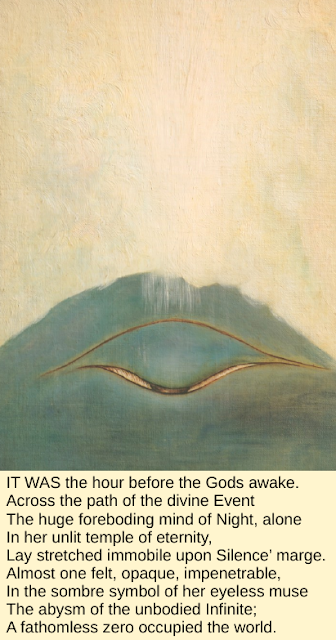IT WAS the hour before the Gods awake.
Across the path of the divine Event
The huge foreboding mind of Night, alone
In her unlit temple of eternity,
Lay stretched immobile upon Silence’ marge.
Almost one felt, opaque, impenetrable,
In the sombre symbol of her eyeless muse
The abysm of the unbodied Infinite;
A fathomless zero occupied the world.
The word "awake" indicates cycles (as in a day of activity and a night of rest repeatedly). In every cycle there is a creation and obscuration. The poem starts with a description of that darkest hour before the Dawn at which Lords of Creation will again come with their creative impluse to carry forward the evolution of conciousness. In India's temple-life for thousands of year it has been a religio-mythic tradition where around 3-4 am everyday the bells are rung to awaken the deites. Lying across the path of that Divine Event when these Lords will awake, is that Night which senses something terrible is going to end her rule. The mind of the Night is apprehensive about this coming of divine event, as if on a border of a silent, immobile eternity. She is symbolically denoted as lying in her temple stretched, alone and absorbed in a dreamy contemplation (muse) without vision giving us feeling of the infinity of a vast ocean which cannot be penetrated. At this hour, it is as if whole world is filled with a deep mysterious and sad nothingness. The eye painted by Huta portrays the Night in that dreadful absorption, fearing the dawn of a special day.

Sri Aurobindo begins his epic with an allusion or an indirect reference to cycles. 'Cycles' is one of the key teachings in theosophy. The very seal or emblem of the theosophical movement consists of a serpent swallowing its tail, representing the cycles of nature. Originating in Egypt, it was called by the ancient Greeks (oura (οὐρά), meaning "tail," and boros (βόρος), meaning "eating") Gnostics and alchemists 'ouroboros': a circular symbol depicting a snake or dragon devouring its own tail, representing the eternal cycle of destruction and rebirth. It means the perpetual cyclic renewal of life and death (or rest), the concept of eternity, and the cyclic return or reincarnation. In Hindu cosmology and in theosophy, the concepts of'manvantara' and 'pralaya' denote a cyclic model of the universe of alternating phases of creation and dissolution. H.P. Blavatsky, in Key to Theosophy, says:
"As the sun arises every morning on our objective horizon out of its (to us) subjective and antipodal space, so does the Universe emerge periodically on the plane of objectivity, issuing from that of subjectivity—the antipodes of the former. This is the "Cycle of Life." And as the sun disappears from our horizon, so does the Universe disappear at regular periods, when the "Universal night" sets in. The Hindus call such alternations the "Days and Nights of Brahma," or the time of Manvantara and that of Pralaya (dissolution). The Westerns may call them Universal Days and Nights if they prefer."
There are many allusions in Savitri, some of which are studied in the article "Allusions in Savitri: A Note by Shraddhavan" in the journal Volume 31 'Invocation' of Savitri Bhavan, Auroville, India.
The 'Gods of Sri Aurobindo who awake' are in theosophy and 'A Treatise on Cosmic Fire" by Djwal Khul and Alice Bailey, the 'Lords of the Seven Rays': the seven cosmic intelligences that govern the evolution of the universe.




Comments
Post a Comment